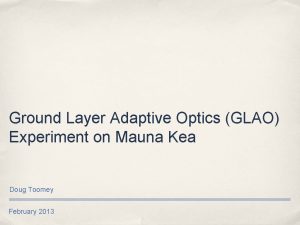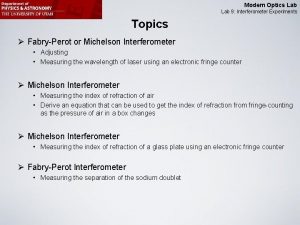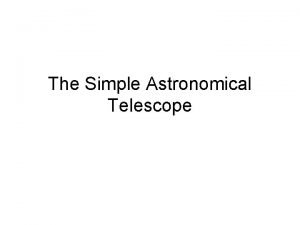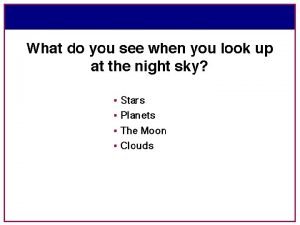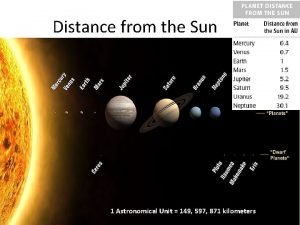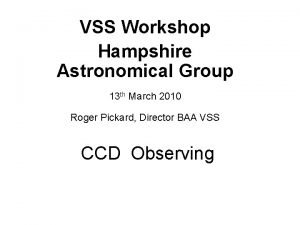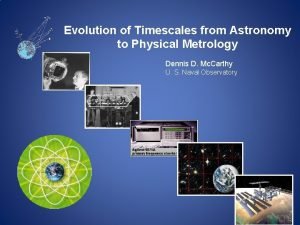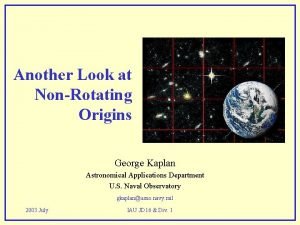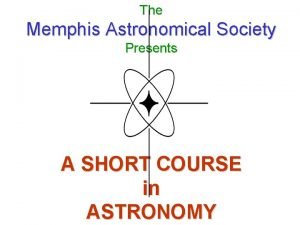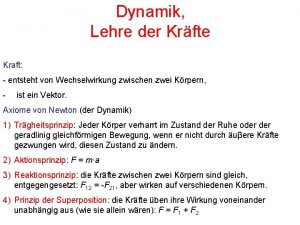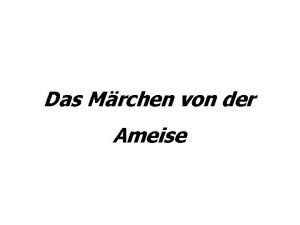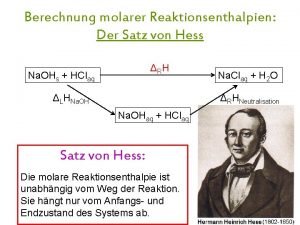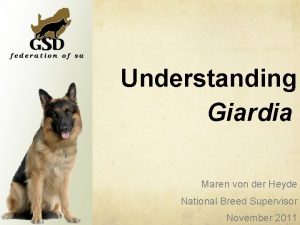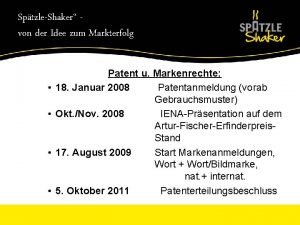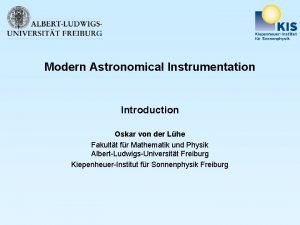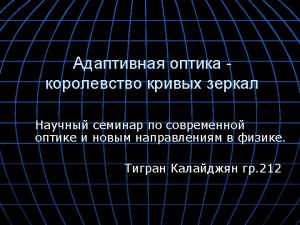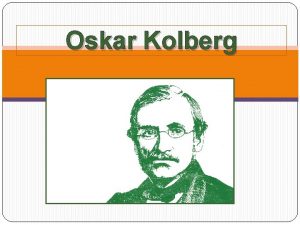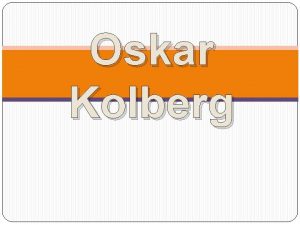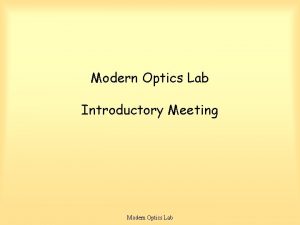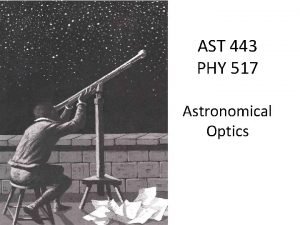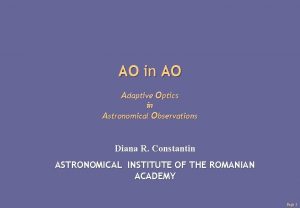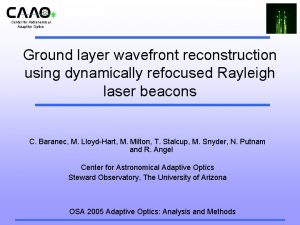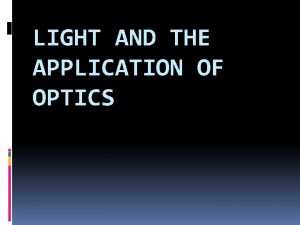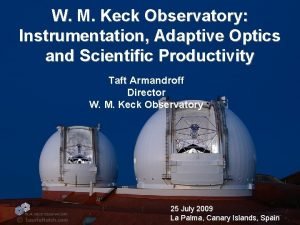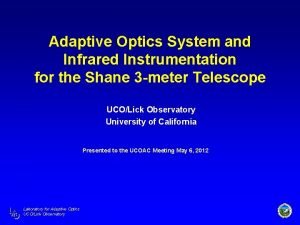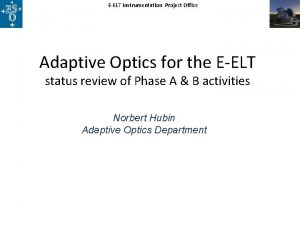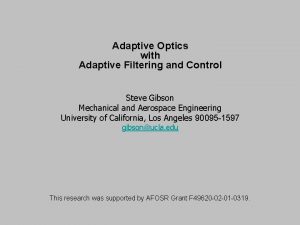Modern Astronomical Instrumentation Adaptive Optics Oskar von der
































- Slides: 32

Modern Astronomical Instrumentation Adaptive Optics Oskar von der Lühe Fakultät für Mathematik und Physik Albert-Ludwigs-Universität Freiburg Kiepenheuer-Institut für Sonnenphysik Freiburg

What is Adaptive Optics? • Telescopes and instruments suffer from static and dynamic aberrations – Optics design – Imperfections from fabrication – Time-dependent gravitational and thermal load on structure and optical elements – Turbulent variation of index of refraction in the Earth‘s atmosphere • Passive measures for remedy – Stiff telescope mounts and optical elements (expensive) – Thermal control – Selection of sites with low ambient turbulence (high mountains near coasts or on islands) • Active measures for remedy – Active optics (large amplitude, slow, predictable) – Adaptive optics (small amplitude, fast, unpredictable) Modern Astronomical Instrumentation - Adaptive Optics 2

Evolution of Adaptive Optics • • Archimedes & Roman Fleet (AD-215) 1950 s: Initial concepts in the US and the Soviet Union – – • • • H. W. Babcock (1953) V. P. Linnik (1957) correctors artificial guide stars 1960 s: First control systems for laser- projection 1970 s: First imaging systems 1980 s: Complex systems for large telescopes (1. 5 m) to image Earthorbiting satellites in the militärischen sector (AMOS, CIS) ESO development of AO for astronomiy 1991: US Air Force releases results of previously confidential development 1990 s: About 20 research groups in USA and Europa develop AO for astronomical telescopes 1993: First test of ADONIS at the ESO 3. 6 m telescope ADONIS becomes the first user facility AO system 1994: AO-System of the University of Hawaii on the 3. 6 m CFHT, Mauna Kea, improved in 1996 (Hokupa‘a) 1997: First AO system on a 10 m telescope (Keck II) 1999: First solar AO system at DST, NSO 2003: First demonstration of solar multi-conjugate AO at VTT 2012: First light for nighttime MCAO system Ge. MS at Gemini S Modern Astronomical Instrumentation - Adaptive Optics 3

Modern Astronomical Instrumentation - Adaptive Optics 4

Modern Astronomical Instrumentation - Adaptive Optics 5

Compensation of a Laser Source Modern Astronomical Instrumentation - Adaptive Optics 5 -6

Wavefront Deformation and Star Image Modern Astronomical Instrumentation - Adaptive Optics 5 -7

Adaptive Optics Sytem ADONIS ESO, 3. 6 m telescope La Silla, 1993 Open and closed loop pictures of a star. Modern Astronomical Instrumentation - Adaptive Optics 5 -8

Solar Adaptive Optics „KAOS“ locking on solar granulation Vacuum Tower Telescope, Tenerife Modern Astronomical Instrumentation - Adaptive Optics 5 -9

Adaptive Optics System Design An adaptive optic system is a multi channel closed loop control system, which consists of • • wave front sensor corrector control unit optical control path Störgröße (externe Störungen, Nulldeformation des Korrektors) Messort Optische Regelstrecke 1 Optische Regelstrecke 2 korrigiertes Bild Stellgröße Wellenfront. Sensor Korrektor Rückführgröße Regelglied Regler Führgröße Modern Astronomical Instrumentation - Adaptive Optics 5 - 10

5. 2. 1 Wellenfrontsensoren Methoden zur Wellenfrontmessung nach J. W. Hardy: Direkte Methoden (Pupillenebene) Zonale Messung Indirekte Methoden (Bildebene) Pupillenadressierung Shack-Hartmann – Sensor (Gradient) sequentielle Bildverschärfung Shearing-Interferometer (Gradient) Frequenzkodierte Bildverschärfung Pyramidensensor (Gradient) Bildebenenkodierung (Gradient) Krümmungssensor (2. Ableitung) Modale Messung Bildbewegungssensor Entfaltung Phasen-diverse Entfaltung Fokussensor Modern Astronomical Instrumentation - Adaptive Optics 5 - 11

Wave Front Sensors • Methods for wave front sensing (J. W. Hardy) Direct Methods (pupil plane) Zonal detection Indirect Methodsn (image plane) Pupil addressing Shack-Hartmann – sensor (gradient) sequential image sharpening Shearing Interferometer (gradient) Multidither image sharpening Pyramid sensor (gradient) Image plane coding (gradient) Curvature sensor (2. Ableitung) Modale detection Image motion sensor (tracker) Deconvolution Phase diversity Focus sensor Modern Astronomical Instrumentation - Adaptive Optics 12

Shack-Hartmann Wavefront Sensor • • • Division of pupil with a lenslet array Each lenslet produces an image of the target which is shifted from the center position according to the local wavefront tilt A detector in the common image plane detects the image shifts Modern Astronomical Instrumentation - Adaptive Optics 5 - 13

Shack-Hartmann sensor with 36 sub-apertures looking at a small sunspot on the solar surface Modern Astronomical Instrumentation - Adaptive Optics 5 - 14

Modern Astronomical Instrumentation - Adaptive Optics 5 - 15

Correlating Shack-Hartmann sensor with 112 sub-apertures in quadratic geometry. Left: image plane, right: cross correlation functions. Modern Astronomical Instrumentation - Adaptive Optics 5 - 16

Lateral Shearing Interferometer shift Incoming wave front Shearing. Interferometer Superpsoition of shifted wave fronts Modern Astronomical Instrumentation - Adaptive Optics Interferogram 5 - 17

Modulating Lateral Shearing Interferometer • • A moving grating replicates the wavefront by diffraction The fringe pattern is modulated in time Bewegungsrichtung deformierte Wellenfront Beugungsgitter in Bildebene Interferogramm Modern Astronomical Instrumentation - Adaptive Optics 5 - 18

Foucault Test and Pyramid Sensor Image plane with Knife Edge Focal plane Pupil plane with wavefront gradient Prism Pupil Lens Detector with pupil images Modern Astronomical Instrumentation - Adaptive Optics 5 - 19

Correcting Elements • • Correcting elements are reflecting or refracting optical elements which can be locally deformed Reflected or transmitted wavefronts show corresponding local deformations Principle of reflective (left) and refractive (right) correctors Modern Astronomical Instrumentation - Adaptive Optics 5 - 20

Characteristics of Correctors • • Number and arrangement of actuators – Determines the complexity of wavefront deformations which can be mapped Dynamic range („stroke“) – Determines the amplitude of deformation which can be corrected Spectral range – Determines the transmitted or reflected spectral range Temporal frequency response – Determines the time scale of doefromations which can be corrected Residual wavefront error – Determines the quality of the corrected wavefront Influence function – Determines the interaction between neighbouring actuators Hysteresis Power dissipation Modern Astronomical Instrumentation - Adaptive Optics 22

Modern Astronomical Instrumentation - Adaptive Optics 5 - 23

Modern Astronomical Instrumentation - Adaptive Optics 5 - 24

Modern Astronomical Instrumentation - Adaptive Optics 5 - 25

Control System • • • The control system combines wavefront sensor and corrector Closed loop system: – The sensor follows the corrector in the optical path – The control criterion is zero wavefront error at the WFS Open loop system: – The corrector follows the sensor – Strictly liniear system required Störgröße (externe Störungen, Nulldeformation des Korrektors) Messort Optische Regelstrecke 1 Optische Regelstrecke 2 korrigiertes Bild Stellgröße Wellenfront. Sensor Korrektor Rückführgröße Regelglied Regler Führgröße Modern Astronomical Instrumentation - Adaptive Optics 5 - 26

Control System • • An adaptive optics system can be considered a linear system The wavefront sensor produces a number of measurements which characterize the (deformed) wavefront – SH sensor: M subapertures with two shift measurements in x and y 2 M measurements The corrector has a number of channels which independently control WF deformations – Deformable mirror with N actuators The goal is to derive N actuator drive signals from 2 M measurements 1 XY N 1 M Modern Astronomical Instrumentation - Adaptive Optics 27

Control Strategy • PWj – projection operator for the j-th WFS signal Modern Astronomical Instrumentation - Adaptive Optics 28

Control Strategy • • Determine the corrector drive signals for the deformable mirror which produce an optimal fit to a basis function The easiest way is to „poke“ each actuator in turn and to decompose the resulting mirror deformation into basis function coefficients (response matrix) There is a limit KDM for the basis index for which the DM is capable of producing a useful response Invert the response matrix to produce the actuator matrix P 2 Modern Astronomical Instrumentation - Adaptive Optics 29

Control Strategy • The WFS matrix P 1 projects wavfront sensor measurements into mode coefficient space • The mode vector m can conditioned by a weight matrix W • The weighted mode vector m‘ is used to generate the actuator signals with the actuator matrix P 2 • The full control chain is the product of all matrices – reconstructor matrix Modern Astronomical Instrumentation - Adaptive Optics 30

Control Strategy • • The total number of modes which can be compensated detemines the number of degrees of freedom (DOF) of the AO system The number of DOF is detemined by the limits KWFS and KDM In a well designed system, KWFS > KDM – Otherwise, degrees of freedom of the DM are wasted Example: hexagonal HS-WFS with 37 subapertures, segmented DM with 37 hexagonal segments. Overall NDOF = 72 Modern Astronomical Instrumentation - Adaptive Optics 31

37 -Segment-AO-System Simulation of • WFS signals (top), • reconstructed Zernike coefficients (center) • axial shifts of the hexagonal DM segments (bottom left) • correlation with true shift (bottom right) Modern Astronomical Instrumentation - Adaptive Optics 5 - 32

Modern Astronomical Instrumentation - Adaptive Optics 5 - 33
 Difference between ray optics and wave optics
Difference between ray optics and wave optics Venn diagram of geometric optics and physical optics
Venn diagram of geometric optics and physical optics Adaptive optics
Adaptive optics Modern optics experiment
Modern optics experiment Angular magnification
Angular magnification Sc002 constellation chart
Sc002 constellation chart Seasons diagram
Seasons diagram Hampshire astronomical group
Hampshire astronomical group Astronomical time scale
Astronomical time scale Star collimation
Star collimation Julie ramer
Julie ramer Guildford astronomical society
Guildford astronomical society Astronomical applications department
Astronomical applications department Memphis astronomical society
Memphis astronomical society Solstice definition
Solstice definition Astronomical
Astronomical Astronomical clock lyon france
Astronomical clock lyon france Wind von backbord weicht wind von steuerbord
Wind von backbord weicht wind von steuerbord Erasmus von rotterdam beeinflusst von
Erasmus von rotterdam beeinflusst von Alexander von humboldt and carl ritter
Alexander von humboldt and carl ritter Bettkante stoßen
Bettkante stoßen Gerd von der lippe holmenkollstafetten
Gerd von der lippe holmenkollstafetten Lehre von einer anziehungskraft
Lehre von einer anziehungskraft Gedicht ameise arbeit
Gedicht ameise arbeit Besonderheiten von der erde
Besonderheiten von der erde Verseifungszahl kettenlänge
Verseifungszahl kettenlänge Von der hexe die einen drachen heiratet
Von der hexe die einen drachen heiratet Minnesang walther von der vogelweide
Minnesang walther von der vogelweide Der gute mensch von sezuan referat
Der gute mensch von sezuan referat Satz von hess definition
Satz von hess definition Coccidia in kittens
Coccidia in kittens Maren von der heyde
Maren von der heyde Von der idee zum markterfolg
Von der idee zum markterfolg


